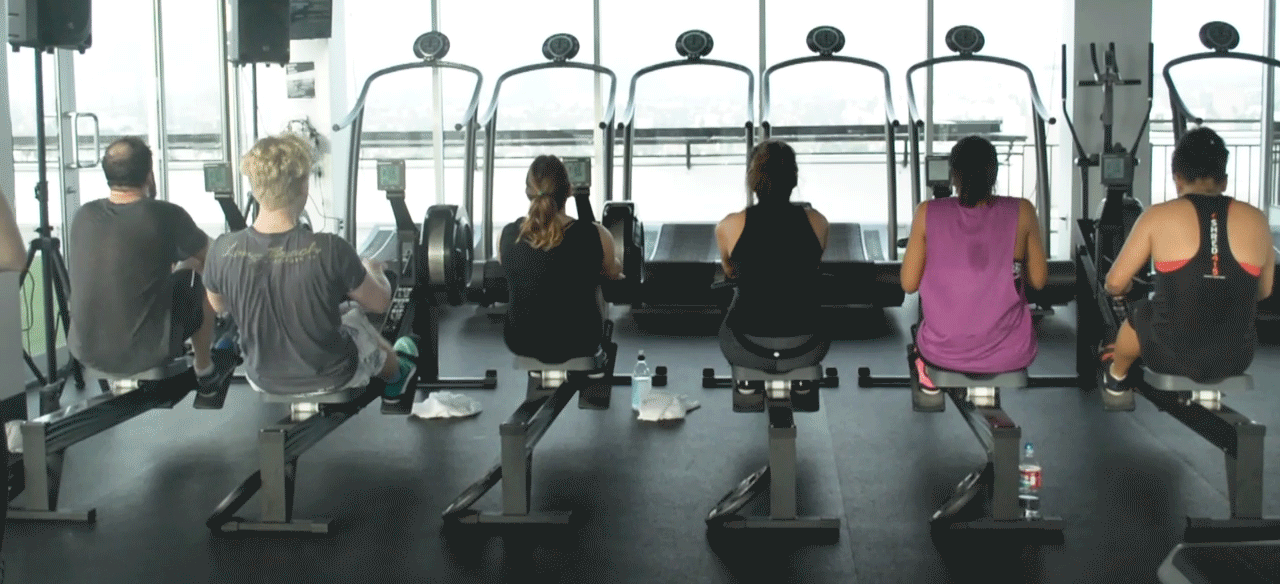Finding Your Fit
Boutique fitness is all the rage in LA, but what keeps clients coming back to these studios day after day?
If this video does not play, click HERE
C ool morning air hit Kathy Yee’s face as she stepped out of Rise Nation — one of LA’s most popular up-and-coming fitness studios — and onto the West Hollywood sidewalk.
The fitness class left her feeling energized, but that 55-minute sweat session wasn’t the only workout she’d be getting that day.
Yee, who is employed in the investment banking industry, often works out twice a day at LA’s boutique fitness studios. And by “boutique,” we’re not talking Step Aerobics, Jazzercise or Les Mills group classes at a local LA Fitness gym. These exclusive studios each focus on a specialized discipline and seek to deliver a unique, personalized environment.
But from the loud, fluorescent-lit lobby of a SoulCycle location to the sauna-like, mellow vibe of a hot yoga studio, what these studios have in common are the fitness elites they attract.
Last year, Kathy Yee attended 411 boutique fitness classes in 281 days. She is one of many Angelenos who work out at such studios multiple times a day.
Courtesy Kathy Yee
“When you work in small studios, you get the same people over and over,” Yee said. “I can say every one of my studios knows my name, knows how hard to push me and knows my strengths and weaknesses.”
Celebrity reporter and fitness blogger Jessica Carroll works out at boutique studios six or seven times each week. A regular at LA studios like Box and Burn, Pilates Platinum and F-45, she agrees that exclusive boutique studios help her push her limits.
“I don’t go to big gyms anymore,” she said. “I got rid of my Equinox membership and stopped going to 24 Hour Fitness.”
Being a diehard member of LA’s boutique fitness community is an often-costly lifestyle choice, both physically and financially.
For Yee, getting the chance to work out at studios like Rise Nation takes precedence over other items in her budget.
“I prioritize,” Yee said. “I’d rather not drink if I know that means I’ll get to work out every day. I’ll make sacrifices.”
Carroll makes similar choices: “If I’m going to invest in one thing, it’s going to be myself,” she said. “I’d rather invest in being healthy than eating out.”
Yee and Carroll are far from the only ones sacrificing certain luxuries to stay loyal to a boutique fitness regimen. These sleek, exclusive studios are winning the hearts and bodies of countless other Angelenos.
In fact, boutique studios are currently leading the fitness industry in participant growth. From 2012 to 2015, nationwide boutique studio membership grew over 70 percent, while traditional gym membership grew 5 percent. Now, studios account for over 35 percent of overall health club membership, according to the International Health, Racquet and Sports Club Association.
But with these statistics come several questions.
What strategies do boutique fitness studios use to make sure pricey workout classes remain at the forefront of their clients’ personal budgets? How do the most successful studios set themselves apart in a market of countless options? And, most importantly, is boutique fitness really helping clients become their best selves, or are the promised benefits of these flashy Hollywood workouts simply a myth masked behind inspiring aesthetics and killer playlists?
Some say boutique studios give clients a quality workout that can’t be replicated anywhere else. Others don’t necessarily understand the hype but support boutique fitness because it encourages an active lifestyle. Still, others say these workouts can be detrimental to certain clients.
What will you think?
Throw on your yoga pants, clip in your spin shoes, and stay tuned.
Maybe There is an “I” in Team: Running With the CrossFit Mentality
My whole body shook and sweat poured down my face through the final treadmill sprint of a circuit class at Speedplay LA. Every fiber of my being told me to stop, but the instructor’s voice kept me going. “Don’t stop … you’ve come so far … we can all get through this together” seemed to be on repeat into the microphone.
The voice propelled me back to the end of a hard three-hour swim practice during my sophomore year of high school. My teammates and I were struggling to make the intervals for our final set, but every time we stopped at the wall in between repetitions we’d hear our coach bellow, “Don’t stop. You better not give up now!” The tone of his voice made clear that he meant every word. We would find it within us to finish the set. There was no other option.
“Five … four … three … two … one … you’re done!” I snapped back to reality and collapsed into the handlebars. I did it. Sure, it was only a 55-minute circuit class, but mentally it took me to a place I was all too familiar with during my 15 years as a competitive swimmer.
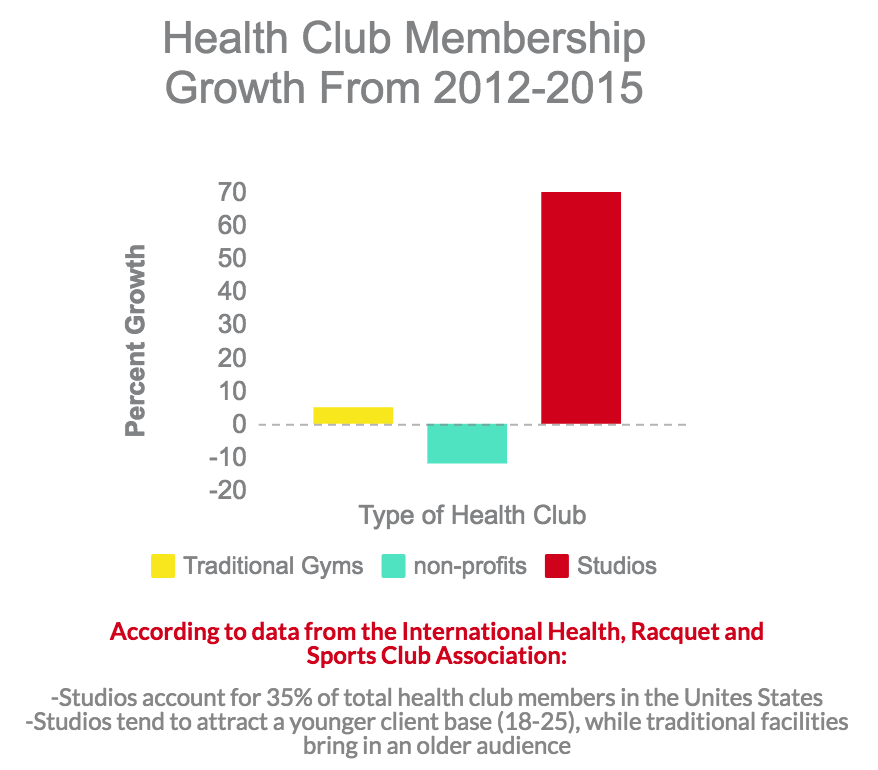
Graphic by Katie Giacobbe
Like me, most Americans were part of some kind of team growing up. Whether it be a school sports team, an academic team, the cast of a school play or a fine arts group, most of us have had some kind of experience working with others from a young age.
But working together doesn't need to stop after childhood. Boutique fitness studios bring a team element to adult clients’ everyday workouts — a major reason that clients, trainers and experts alike credit them for being so successful.
“People are social animals,” said John Callaghan, a sports psychology professor at the University of Southern California. “We’re much more content working with a group or team than we are working alone. And that’s why teams, even now, are successful even at the adult level.”
Callaghan, who grew up playing sports in Europe, said he has seen massive growth in the American health and fitness industry over the past 15 to 20 years. He believes group fitness is causing an increase in Americans’ desires to be fit through their adult lives.
“People used to quit [team sports] at an early age and that was the end of their activity level,” he said. “Now, people are realizing that exercise is very, very good for you emotionally, physically and psychologically.”
The boutique fitness industry thrives off the mentality that exercise is wholistically beneficial and pairs it with a team aspect that adults strive for and often lack. With this sometimes comes a club or cult-like atmosphere.
Fifteen years ago, CrossFit founder Greg Glassman used the simple concept of teamwork to start a global phenomenon of boutique gyms. The program, now available in 142 countries, emphasizes community and measurable skill development to keep clients coming back for more.
“The group environment makes it a lot more consistent for people because it’s very hard, and when you do hard things with people you like, it makes you want to be more consistent,” said Justin Bergh, general manager of the CrossFit Games, an athletic competition the company established with partner Reebok in 2007. “It’s a double-edged sword because you get more fit and you get more time with the people you like, so there's a lot of natural incentives to continue with the program.”
Media by Katie Giacobbe/ Photos courtesy Creative Commons
A former college athlete, Bergh found CrossFit after many years of lacking the team camaraderie he once had on the playing field. The way his CrossFit trainers and peers pushed him instantly got him hooked.
“All the friends I had [growing up], we got yelled at together and we tried to win together,” he said. “When I got done, I traveled and worked a lot, but I didn't feel like I developed any new close, personal friendships. But I walked into a CrossFit gym and I was like, ‘Hey, I get yelled at and people expect a lot out of me.’ You feel like you just got done with a conditioning practice. I was like, ‘Man, I want that again.’”
But as with most of today’s boutique fitness trends, Bergh stressed that CrossFit isn’t just for athletes.
“There’s people that never had a single athletic bone in their body that found CrossFit and were like, ‘Oh, I just love it!’ ” he said.
The company went a step further and founded the CrossFit Games for that reason — so the average CrossFitter in his or her hometown gym would be able to relate to, and train the same way as, elite athletes. Since CrossFit competitions are now televised the same way as professional sporting events, members who never played a sport before are taken out of their role as “fan” and placed in the role of “competitor.”
“That’s what makes our culture different,” CrossFit Media Director Sevan Matossian said. “We are all the same and we all benefit from fitness. I want people to say, ‘Wow,’ I’m so happy I got to be in this arena with other people who are CrossFitters.’ We want people to go home and be inspired to train.”
But, while CrossFit can be found worldwide, why is the United States the hub for the boutique fitness industry as a whole?
Callaghan attributes this to the country’s predominant focus on elite-level sports from a young age. This has led to a lack of opportunities for the average athlete to play competitively at the collegiate level and above.
“We’ve done a peculiar thing in our high schools,” he said. “We’ve emphasized organized sport but left the general population behind. All we’re concerned about are the competitive teams. We’re concerned with elitism.”
In contrast, he said, Europe offers many more opportunities for athletes of all ages and abilities to play at a competitive level.
But Callaghan said that group fitness classes are making up for what he believes Americans should be doing for their children and teens — which is to allow them to be involved in competitive athletics regardless of ability.
“We didn’t really take care of them, and now, these people that graduated from high school and college are realizing that their health is a huge, huge issue,” he said. “And so, they realize they need to be active. [Group fitness] is absolutely wonderful for our society to actually get people involved."
It’s never too late to join a team.
Biking Into the Cult: How a Fitness Trend Is Made
Class was still five minutes from starting, but the latest Drake song was already blaring as I stumbled across a dark room filled with 60 tightly-packed spin bikes to find bike No. 18. I had selected the bike the day before using a brightly-interfaced app that allows riders to choose a bike in a similar way you choose seats for a concert. An 8 a.m. SoulCycle ride in Santa Monica can book up faster than Friday night reservations at Nobu. You need to secure your spot early.

SoulCycle's founders each pocketed close to $90 million when they sold the company to Equinox in 2015.
Photo by Katie Giacobbe
Bike 18 didn’t look any different from the spin bikes I rode at my parents’ local gym growing up. It had the same handlebars, clips and knobs to adjust seat height and tension. I fumbled around in the darkness and wondered what could possibly make this class worth the $30 I paid for it.
The instructor — a 20-something blonde with a six-pack and colorful workout pants — strode into the room, cheerfully greeted a few clients in the front row (obviously regulars) and hopped on her bike, which was elevated on a stage in the center of the room. The studio doors closed and the speakers started blaring a strange EDM remix of “Work Out” by J. Cole.
The 45 minutes that followed launched me into a different world.
The instructor yelled into the mic for us to stand up, sit down, tap back and crunch our arms in and out, all along to music that made me feel as if I were at the front row of the Coachella Main Stage. The 59 other riders and I all seemed to move in sync, and my body followed even when it felt like it couldn’t anymore. I stumbled out of the studio dripping in sweat and realized I had never worked so hard in a spin class. As much as I hated to admit it, I’d pay that $30 again.
I’m not the only one who became submerged in SoulCycle’s 45-minute alternate reality. Founded in New York in 2006, the company how has over 70 boutique studios nationwide, all of which charge $30 to $40 for a 45-minute ride. Despite the hefty cost and no monthly unlimited option, it has been hugely successful. So successful, in fact, that SoulCycle’s founders pocketed around $90 million each by selling the company to Equinox in 2015.
So how on earth did packing 60 spin bikes into a dark room make millions?
David Austin, who serves as a personal trainer for group and private clients in the LA market, says SoulCycle is successful because almost anyone can do it.
“Basically anyone — even people with double knee replacements — can hop on a bike and exert themselves,” he said. “SoulCycle has taken this modality with very little technical barrier for entry and let people go to town.”
In addition, even clients who are not physically fit can get something out of the workout.

Experts explained key components for fitness studio success.
Graphic by Katie Giacobbe
“People search for the dopamine dose from going hard,” Austin said. “You just bring them in and smash them. People love to sweat.”
Former college swimmer Allison Naasz can attest firsthand to the sweaty endorphin release that SoulCycle provides. She is a frequent client at LA locations and enjoys trying different “theme rides” that primarily play music by a particular artist.
“I actually think I had a spiritual experience at SAMO [SoulCycle’s Santa Monica studio] one night while at a Weeknd-themed ride,” she said. “I've never sweat so much in my life. And the whole experience is super uplifting and positive.”
An atmosphere similar to SoulCycle’s sleek aesthetic can now be found in most of today’s most successful boutique fitness trends. But with new studios springing up in LA all the time, how does a trend come about?
Brand strategist Michelle Spigner and three of her colleagues created an algorithm for building a fitness trend. While the team element is an essential component of group fitness, said Spigner, who visited studios for the first time during her research, many took this a step further to come off as an exclusive club or tribe.
“You do find some commonalities in what people wear, and there’s usually a certain language or terms that people use,” she said. “They’re not all hard-core regulars, but it does feel like a community you’re not really a part of yet.”
But another common aspect of the most successful clubs is that, while there are regulars, almost anyone can get in.
“From the instructor, I never got the sense that people didn’t want you to come into the club,” Spigner said. “As far as the people in the class, there is that sense of who’s been there and there is a little bit of that hierarchy.”
Still, even some of the most obscure boutique fitness trends welcome newcomers with open arms. Sarah Tiefenthaler, founder of the paddle board yoga company YogAqua, opens her classes to clients of any ability — even if they’ve never stood up on a paddleboard or folded into a downward facing dog.
“We begin with paddle instruction and we’re on really calm water, so getting used to paddling is very quick and easy,” she said.
Likewise, Aerial Fitness instructor Lindsey Duggin hosts classes, which she calls AIR Foundation, specifically tailored to beginners.
“I understand it’s a little intimidating at first, but we make this a nice, welcoming community where anyone is welcome to come at any time,” Duggin said.
Beginners are welcomed with the goal that they will want to keep improving their skills, and thus come back for more.
“Practice and consistency is everything,” Duggin said. “When you come once a month you have to re-teach your body again. Repetition is great, coming back three to five times [a week].”
Want to become that rider who gets greeted by instructors in the first row of SoulCycle? Well, this is where you start.
From Reformers to iPads and Everything in Between: How the Most Successful Trends Maintain Clients and Stay Ahead of the Curve
I stepped off the bright West Hollywood street into a black-walled, dimly lit room filled with exercise machines that looked like a strange cross between a Pilates reformer and a Lamborghini.
I regularly attended classes on Sebastien Lagree’s more common training machines, but these new models, dubbed Supraformers, looked as if they were going to take my workout to the next level of intensity. They lit up. They moved up and down. They even tilted from side to side as the clients working out on them held on while performing a challenging lunge exercise.
Lagree, a French native who began his fitness empire in LA, strode over to me and showed me an iPad, which he uses to control the machines’ tilt and incline. Before I knew it, I was lunging on a machine as well, and struggling to find stability through an exercise I normally performed with ease.
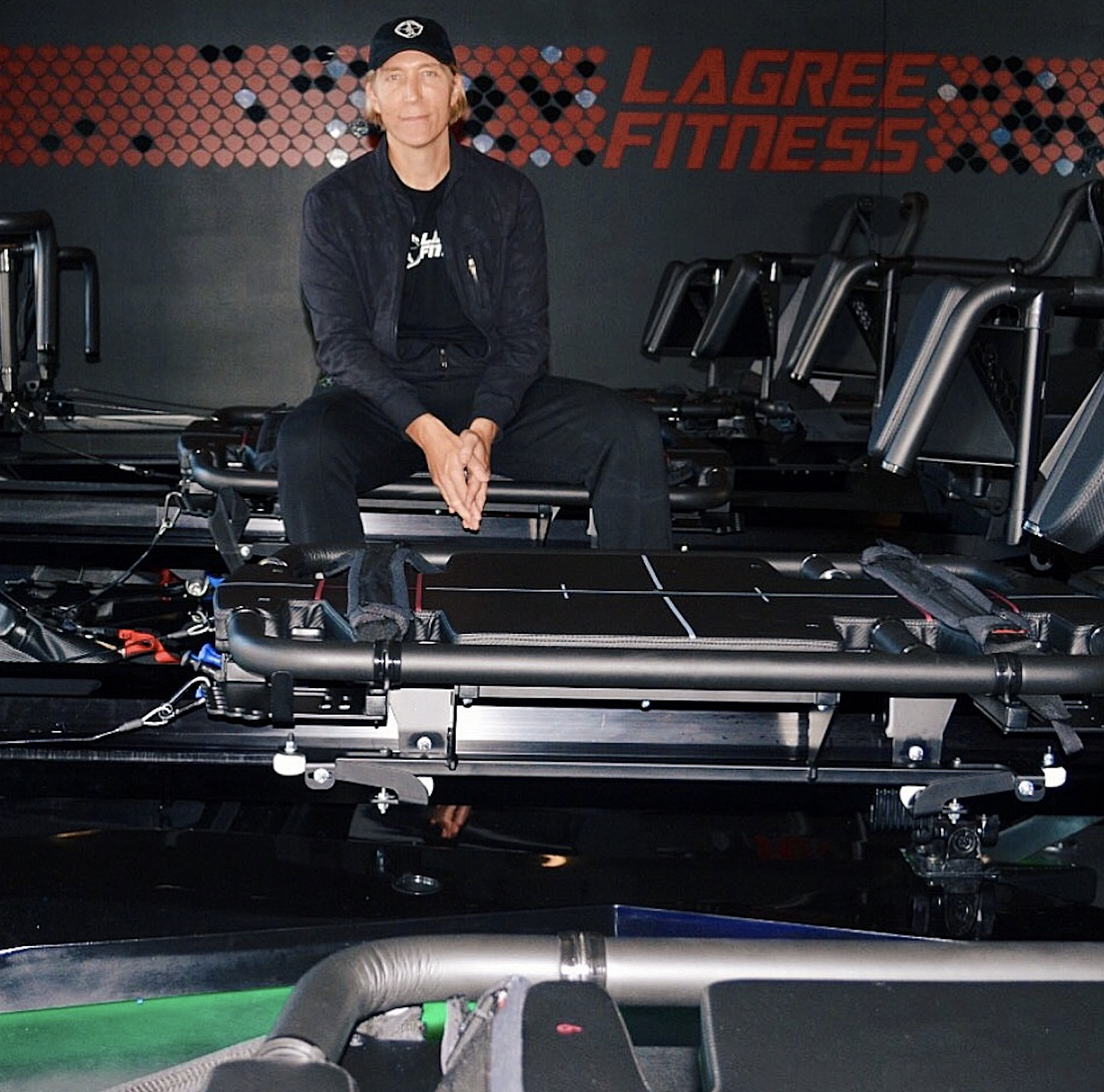
Trainer Sebastien Lagree incorporates technology into his workout method/ Photo by Katie Giacobbe
By the end of the workout, which, thankfully, lasted only 25 minutes, my body was shaking through even the simplest moves. The Supraformer had brought me back to the basics of a fitness method I usually excelled at. I was in awe.
Lagree invented the Supraformer for a reason: to keep his fitness trend evolving.
His company, Lagree Fitness, was conceived in the early 2000s when he discovered a Pilates reformer machine and began using it to train clients.
“I never trained people in the Pilates style,” Lagree said. “I used the reformer as a fitness machine.”
Lagree opened his own Pilates reformer group fitness studio but soon saw the need for machines that were more customized to his training style. The Proformer, Lagree’s first model, was born in 2006. It has since evolved into two more models— the Megaformer and now the Supraformer— with each model talking on new developments year to year.
“I make everything from scratch,” Lagree said. “Everything you see is made for this type of machine. We don’t just go to Home Depot and mock something up.”
Lagree says it takes him about five years to fully develop a fitness machine. The Supraformer, which currently can only be found at Lagree’s flagship studio in West Hollywood, is in its fourth year of development. The machine and the iPad it is paired with serve as a testament to Lagree’s belief that technology is essential to evolving a fitness trend.
“I believe we need to develop a healthy relationship with technology,” Lagree said. “When I look at the future, teachers are going to be less focused on the little details of the machine and can really focus on the experience. They can focus on what humans are good at, which is to motivate, to inspire — to connect.”
But evolution comes at a hefty cost. Owners of licensed Lagree Fitness studios are dishing out $100 per machine per month. Newer machines cost around $10,000 to fully pay off.
Despite the cost, Lagree’s method is growing. Rapidly. The fitness entrepreneur’s machines can now be found in over 300 boutique studios worldwide, with locations springing up in Europe, Australia and potentially China.
“From 2006 to 2009 sometimes I’d get nothing for a few months and it was very slow,” Lagree said. “Now, there are studios opening almost every week.”

Sebastien Lagree's Supraformers are controlled using iPad technology. These machines can only be found in his West Hollywood flagship studio/ Media by Katie Giacobbe
Continually updating equipment is not the only ingredient in the recipe to keep a fitness trend popular. Michelle Spigner, the brand strategist, found that the most successful fitness trends have the clearest identities. Fitness brands attract a certain type of client by marketing themselves a certain way. They keep those clients around by maintaining and building upon their marketing techniques.
“You can describe a Lexus versus a BMW person,” she said. “You can describe a CrossFit versus a Barre versus a SoulCycle-type person. You can see the type of bodies they’ve produced. Whether it’s very aggressive like CrossFit or very inspiring like SoulCycle, it allows you to segment yourself and see what you’re interested in.”
With a mood comes an aesthetic. Take SoulCycle’s white-walled lobby, Lagree’s sleek and dimly lit studio or the grungy, sweat-filled CrossFit gym. Each evokes a certain, distinct feeling that appeals to a certain, distinct clientele.
“You can roll a bike into the multi-purpose room, but now it’s about transforming that space and finding something that really differentiates you and puts you in that mindset,” Spigner said.
That blond instructor with the six-pack and colorful workout pants is part of your aesthetic too.
“People look for the body they want in the instructor,” Spigner said. “The instructor is the spokesman of the program.”
And lastly, what better motivation to come back to a fitness class than having a goal to reach? Justin Bergh of CrossFit attributes a great deal of his company’s success to the program’s goal-setting mentality.
“There’s a component that is technical and it requires you gain skills in order to evolve in your training,” he said. “I think a lot of programs appear to me to be different in that they don’t focus on skill acquisition. Some of the hallmarks of CrossFit are it’s an objective program done in a group environment.”
So, which trend do you identify with?
The Push Into Mediocrity?: How Boutique Fitness Is Affecting Traditional Workout Methods
David Austin was discontent with the personal training he was doing. The former University of Arizona diver had owned a CrossFit gym for four years, but he was ready to take a more individualized approach.
“I fell out of love with group exercise,” he said. “I wanted to meet people where they were and take them to where they wanted to go. Everyone’s got a unique journey they have to take.”

Personal trainer David Austin sold his CrossFit gym because he was discontent with group fitness/ Photo courtesy David Austin
Austin sold his CrossFit gym and took up employment at a 24 Hour Fitness facility. It was there that he began training individuals and crafted his philosophy, which focuses on the importance of goals that can be measured and improved over time.
“If you ask somebody to get on the treadmill and run a mile and they do it in 10 minutes, you can design a program that might increase their performance in that mile time,” he said. “So if they stick with the person who measured the mile time and then created the program to improve it, you can go back and re-test. That partnership between who’s helping them identify their highest performance goals — that’s what I mean by consistency.”
Austin stresses the importance of doing workouts that will help clients move toward their fitness goals. He believes that the variety of options provided by the boutique fitness industry is detrimental to helping people achieve this consistency.
“It causes a lot of confusion,” he said. “It’s like the shiny object syndrome where one can’t settle into making fitness consistent in their lives. That’s made it tough for folks that don’t understand the foundational facts of making progress towards their goals. There’s so much out there that they can’t choose one and have someone intelligent paint them a picture.”
Austin also expresses concern about boutique fitness instructors, saying some of them lack knowledge of basic, time-tested fitness protocols.
“These people go through a weekend seminar because they love fitness, which I’m not going to fault them for,” he said. “They teach a yoga class on Tuesdays and a SoulCycle class on Fridays and on Sunday they do Orangetheory, but they’re not helping anyone with that foundational element of consistency.”
Physical therapist and former athlete Dominic Toscano sees options as a positive because more of his clients are exercising as a result of boutique fitness. He says people who otherwise wouldn’t have worked out at all are more likely to find a fitness method they enjoy.
“They may not like a traditional big gym and feel like it’s too much for them,” he said. “Having a smaller gym with something they’re more attracted to doing is a benefit to that person. It has a good impact in a sense that you can touch more people and people can find a way to just get moving.”
Statistics prove that the nation’s involvement in fitness is steadily increasing. According to data from fitness industry trade group IHRSA, the total number of health clubs in the Unites States has gone up every year since 2005 and the country’s total health club membership is on the rise as well. California specifically has seen a 34 percent increase in total number of health clubs.
Austin does agree that boutique fitness can benefit people who don’t regularly exercise.
“If you take a client who’s done nothing and you give them anything, they will get better,” he said.
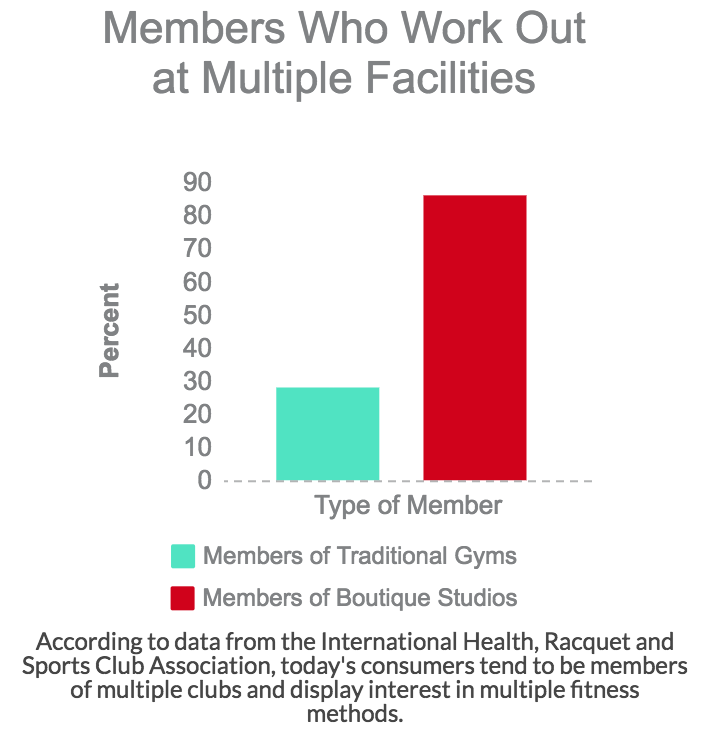
Graphic by Katie Giacobbe
But he believes that people who exercise regularly will have a hard time improving their overall fitness when following certain boutique methods.
“There’s a time and a place where you need to have a more eloquent program design to take someone from an intermediate level to advanced level of fitness,” he said. “What I saw in group exercise was we took a bunch of clients in and I had one workout for the day that I’d put 120 athletes through. If they were new, they would get better every day, and once nine months hit, they’d hit this plateau. A template of group workouts was not meeting their needs.”
Despite the growth of boutique fitness in LA in recent years, Austin doesn't see it as a real threat to the traditional personal training industry. He has seen a “survival of the fittest” trend in fitness fads over time, and believes this will continue.
“We’ve seen fad elements in the fitness industry forever — whether it’s the hula hoop craze or jogging or whatever it may be,” he said. “The hula hoop craze didn’t stick around as a staple in fitness, but jogging did. It’ll depend on who created the fad and how in line it is with strength and conditioning principles.”
And as far as the traditional gym industry goes, many fitness chains have started offering group fitness classes with a boutique studio mentality. These classes are often included in the cost of membership.
“Our studio classes give our members the workout variety they look for to keep them motivated and accountability for their commitment,” a 24 Hour Fitness representative said. “We offer several types of class styles, from cardio to dance to strength training and yoga.”
24 Hour Fitness also noted that, like many traditional gyms, the company offers personal and small-group training options along with areas for members to work out on their own.
With a number of fitness options in Los Angeles that could compete with the number of cars on the 405 freeway at 5 p.m., will the tried-and-true options survive? Or will they be replaced by that shiny new object?
Is it Worth a Second Rent?: How Angelenos Are Making Fitness a Financial Priority
In Los Angeles, a single class at SoulCycle costs $30. Multiply that by a 30-day month and you have $900 — almost the median rent in some LA neighborhoods.
And it’s not just hopping on a bike that will break the bank — most boutique fitness studios charge $25 to $30 for a single class.
Since affording rent can be a challenge of its own, adding a pricey fitness regimen to the mix is a luxury not everyone can afford. That's why boutique fitness owners, if they want to survive in a crowded field, have to find ways to provide value for the price.
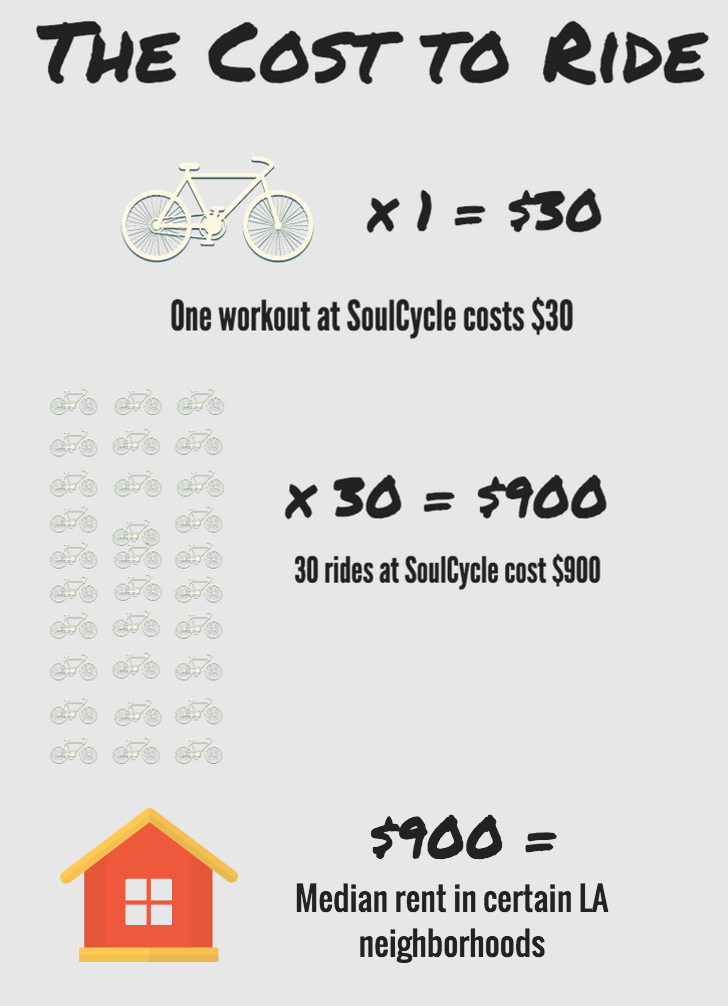
Rent Data provided by zumper.com/ Graphic by Katie Giacobbe
“I did hear some apprehension around prices, but once classes build in something more than a sweat session, it’s motivating,” brand strategist Spigner said. “When it’s more holistic, people appreciate it and see those classes to be more worth it.”
Spigner also noticed that clients tend to drop more cash when they have strong relationships with their instructors, but the experience as a whole has become something many Angelenos are willing to pay a premium for.
“It’s a statement of luxury,” she said. “Wellness as a whole has become a luxury. Being involved in fitness is a reflection on who you are and how you treat that.”
Reporter-blogger Jessica Carroll, who attends boutique fitness classes in LA almost daily, sees the cash she puts toward group fitness as a long-term investment.
“Investing in yourself and your personal health can actually save you money in the long run,” she said. “It could prevent medical bills or diseases or cancer down the road. If you don’t have your health, you don’t have life.”
But there are ways around paying upward of $25 per class to obtain this luxury. Many studios offer monthly unlimited memberships, and if you’re looking for that variety, ClassPass lets clients dip their feet in a few different methods for under $100 a month.
Founded in 2013, ClassPass allows members to attend classes at any participating studio with the option to visit a single studio up to three times each month depending on membership plan. The company provided an unlimited-class option for two years but upset many customers by revoking the unlimited plan in November 2016. Still, thousands of members nationwide enjoy the service, which gives them five or 10 classes per month with options to add on.
University of Southern California student Drew Schwendiman joined ClassPass a year ago when the unlimited plan was still available at $99 a month. He said his membership allowed him to take full advantage of LA’s boutique fitness scene.
“I exercised about four to five times a week and built relationships with studios and trainers,” he said of his experience using the unlimited plan. “At my peak, I exercised 25 times in one month, which rounds out to $7 a class. Many of the classes I took were at least $25 a class, so this was obviously an incredible deal.”
Schwendiman kept his membership even after ClassPass discontinued the unlimited option, but he now finds himself having to be more financially conscious of his studio decisions.
“Now, I pay $115 a month for 10 classes, which is still more affordable than packages at most LA studios,” he said. “What I’ve had to do, though, is use my ClassPass classes at the more expensive studios and pay out of pocket at more affordable studios.”
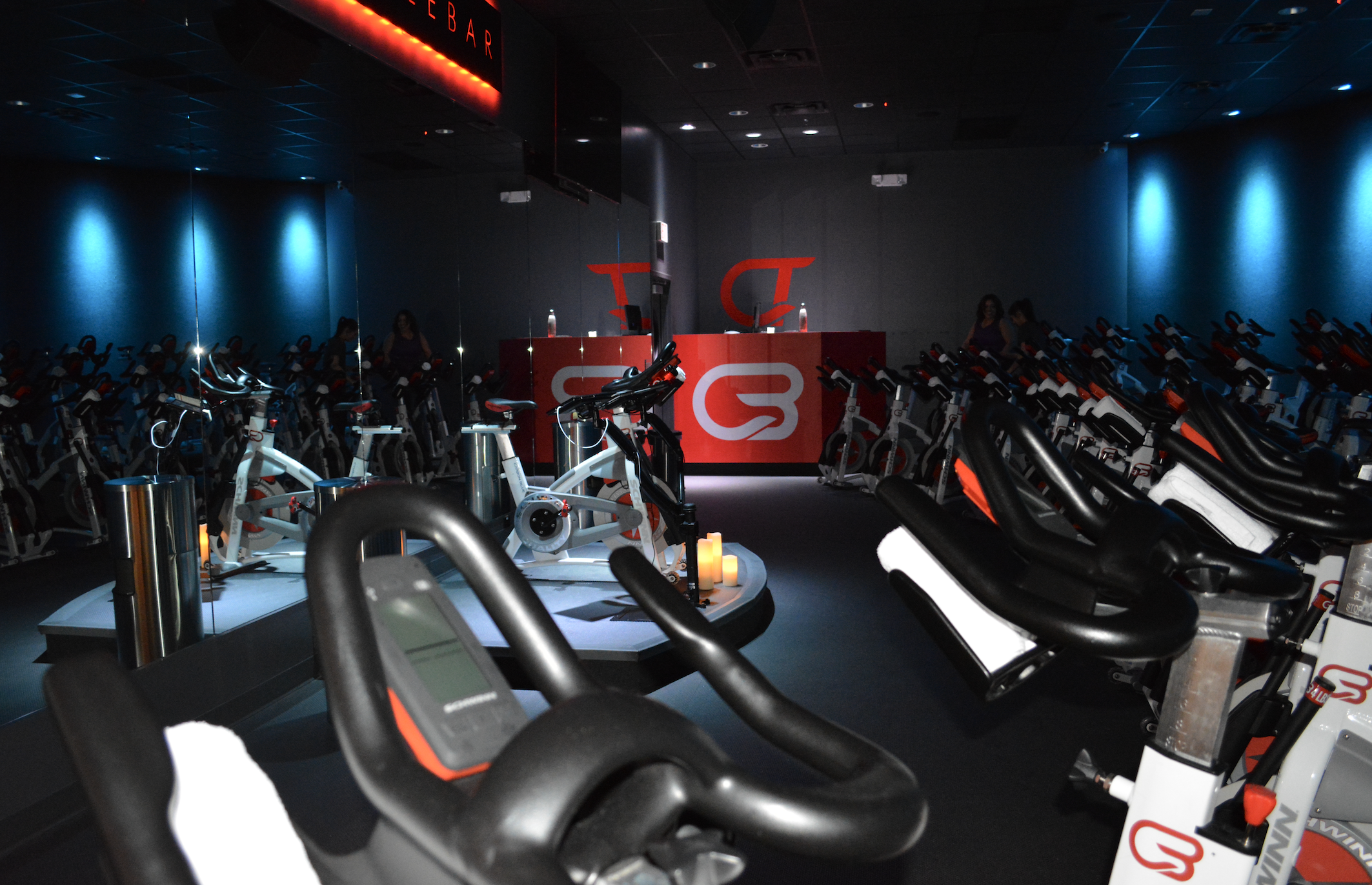
Cycle Bar is one of many LA studios that choose not to be on ClassPass/ Photo by Katie Giacobbe
While ClassPass makes boutique fitness more affordable for clients, how does it affect studios?
Minna Herskowitz, owner of Sandbox Fitness, sees both pros and cons from her decision to use the service.
“The cons are that people don’t want to buy packages directly from your studio because they are spoiled by ClassPass pricing,” she said, “The pros are that it fills up classes that are going on anyway so it's extra income. And we do get some new client clientele from ClassPass that wouldn't have heard of us otherwise.”
While many feel it is worth it to pay big bucks or financially strategize to maintain a daily regimen at their favorite studio, others believe it is dangerous to put a hefty price tag on fitness.
“The people who run these have to be very careful of the price they charge,” said Callaghan, the USC sports psychology professor. “We have to make sure we don’t eliminate a huge chunk of our population that would willingly get involved in these.”
That being said, Callaghan stressed that there are many more affordable ways to get active through LA’s parks and recreational programs. He also stressed the importance of keeping those programs accessible to everyone.
“We’ve got to be very, very careful that we keep these at a financial level where people can join,” he said. “Costs of a lot of our gyms are rising. We’re concerned about health, but we have to make sure we maximize this to allow more people to participate. We deprive a lot of people.”
So, if you had to decide between a boutique fitness class or $30 of groceries, which would you choose?
Just a Phase or Here to Stay?: Looking Toward the Future of Boutique Fitness
I dropped down into child’s pose on my paddleboard after a challenging class at YogAqua. It was a sunny Sunday morning in Marina del Rey, and I took a few moments to feel the sun on my back and listen to the calm water slosh softly against my board.
I thought about how, over a decade ago, it would be completely absurd to see a large group of paddle boarders doing headstands and warrior lunges out on the marina. IPads didn’t exist, so it would be impossible to use one to control an entire fitness class the way Sebastien Lagree does at his West Hollywood studio. And it would certainly come off as outrageous to spend $30 or more for 45 minutes on a spin bike.
But now, workouts like these are the norm for many LA residents. Will we look at the fitness industry over a decade from now and see just as extensive of an evolution?
Carroll believes that boutique fitness studios are here for the long haul, but she thinks that technology will start playing an increasingly greater role.
“I think they might start being run more by technology than by certified trainers,” she said.
Spigner also feels that technology will become more and more integral to fitness. The brand strategist predicts that virtual reality glasses will soon be used on treadmills.
She uses the indoor cycling company Peloton as an example that illustrates her belief that technology will increase while a team atmosphere remains.
“What Peloton is doing is how you retain your tribe while using technology,” she said. “Wherever things go, you’ll still have that tribe.”
While Austin, the former CrossFit gym owner, believes that boutique fitness sometimes impairs regular exercise, he feels that only the most knowledgeable studios will survive. He and Spigner agree that fitness trends have been around for decades, and boutique studios are just part of the evolution.
“Ever since the '80s when everyone in New York was taking aerobics classes, your fitness has a way of showing people who you are,” Spigner said. “I don’t see that changing.”
